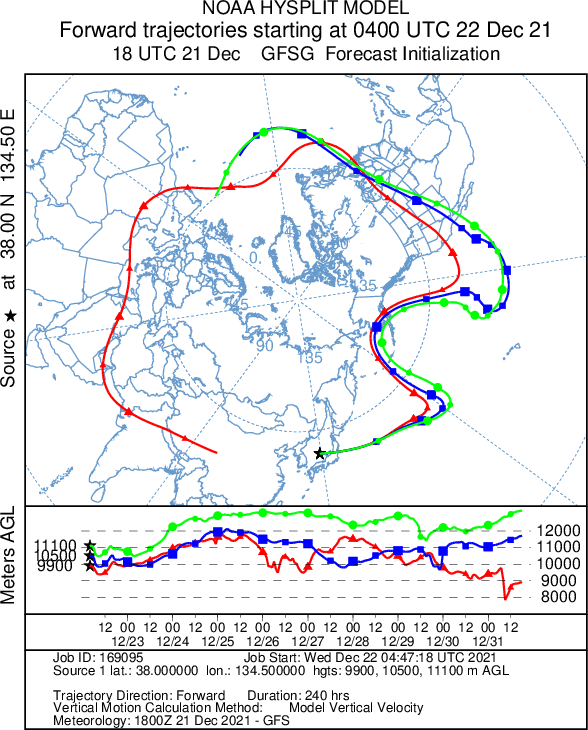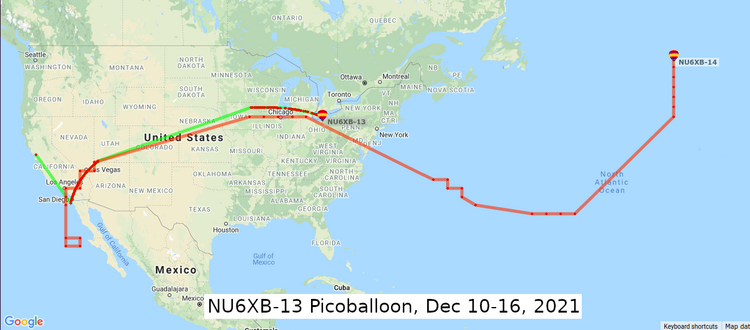The SF-HAB group launched another picoballoon on December 11th, 2021, from the Berkeley Marina. The launch party was Martin W6MRR, Robert K6RGG, and Kazu AG6NS. This picoballoon used two clear Chinese party balloons with hydrogen gas for lift. Martin's custom electronics was used, with a WSPR transmitter that alternated 14 MHz (20 meters) and 10 MHz (30 meters).
The aprs.fi callsign was W6MRR-22 using the WSPR to APRS bridge, and the WSPR callsign was W6MRR.
This picoballoon floated between 9,900 and 11,100 meters (32.5k to 36.5k feet) for the duration of the flight, which is the perfect altitude for picoballoons. This is above most bad weather (rain and thunderstorms), but still low enough to be in the fast part of the jetstream.
From Oakland, this picoballoon headed east at a pretty fast clip. In total, it traveled about 23,000 km (~17,000 miles) in 12 days, for an average speed of about 80 km/hr (~50 MPH).
One interesting thing was that this balloon was not received on Dec 20th and 21st, when it was floating over the Stan countries and Central Asia. We also saw this with the previous launch, and I'm speculating that it's either local GPS jamming or the relative dearth of WSPR receiving stations in that part of the world.
When the picoballoon reappeared in the Sea of Japan, I ran some HYSPLIT predictions.

This prediction showed that the balloon would be floating over Alaska on Christmas Day, but then would head straight south and spend 5+ days out in the North Pacific Ocean before making landfall. Curiously, the lower winds were much stronger/faster than the higher jetstream winds.
Unfortunately, the balloon only lasted one more day. The last location report was from gridsquare RM61 on December 23rd, about 950km west-northwest of Midway Atoll in the North Pacific Ocean. This single packet was heard by the WebSDRs at KPH just north of San Francisco, California.
WSPR Distance
The longest distance WSPR spot for this picoballoon was 19,800km, received by VK4CT in gridsquare QG62jv just north of Brisbane, Australia on December 16th. On this day, the picoballoon was about ~1,000km (~620 miles) west of the Canary Islands in gridsquare HL57iq, off the coast of Morocco.
The antipode (point on the opposite side of the earth) of VK4CT's receive antenna was calculated at only 215 km (~130 mi) away from the balloon's actual position. So our 10 mW signal made it halfway around the world!
This balloon is solar powered and transmits on 14 MHz (20 meters). At this point in the solar cycle, this band really only works in the daytime. We can infer that the transmitted signal headed south over the Atlantic Ocean between Africa and South America, over the south pole, and north to Australia.
Download all the WSPR packets from W6MRR-22 here.
Race with UC Berkeley
Unbeknownst to us, Miki Lustig at UC Berkeley also launched a picoballoon the previous day. They launched from the UC Berkeley campus at around 3:45pm Local time (2345 UTC) on Friday December 10th.
Their picoballoon contained both a WSPR transmitter and 2 meter APRS transmitter, similar to our first few launches. APRS has more precise position data, but the higher transmit frequency limits the range to about 200 miles. Once the balloon ventures out over the ocean, no receiving stations can hear the balloon. WSPR uses a much lower frequency that can bounce around the ionosphere to distant receiving stations.
Their APRS transmitter callsign was NU6XB-13, and the WSPR callsign was KK6MRI. On this map you can see both the APRS beacons on the green line, and the WSPR beacons on the red line.
Since they launched late in the day, the tracker only transmitted a few APRS packets before running out of power. It awoke the next day off the coast of Baja California, out of range of any APRS gateways so only the coarse WSPR gridsquare locations are shown.
This picoballoon floated at an altitude of about 7,900 meters (~25,800 ft), which was significantly lower than W6MRR-22. This lower altitude meant it traveled a bit more slowly east, and was more susceptible to downing by weather. The total distance traveled by NU6XB-13 was approximately 11,000 km (7,000 miles) in 6 days, for an average speed of 75 km/hr (~46 MPH).
The last packet received by the WSPR network was on Dec 16th at 1544 UTC, when the balloon was about 1,600 km (~1,000 mi) east of Newfoundland. Download all of NU6XB's WSPR packets here.

